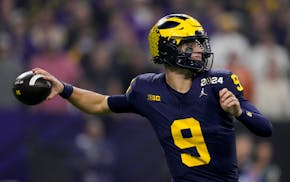Their leadoff hitter isn't getting on base, their No. 3 hitter isn't producing power, their ace has yet to win and they struck out 14 times in a loss Saturday that leaves them at 4-7.
This has not been an ideal start for a team trying to prove it is not as horrid as its four predecessors. For all of the ugly statistics the Twins have compiled this season, there is little to be done about many of their problems.
It would be silly to move or bench shortstop and leadoff hitter Danny Santana, a fine young player in a slump. There is nothing to do about Joe Mauer's anemic slugging percentage other than continue to play him, and perhaps shift him in the batting order. There is nothing to do about Phil Hughes' mediocre three starts other than hope he follows last season's itinerary.
What the Twins can and must change is their center fielder.
Jordan Schafer has not performed well in the field, at the plate or in recognition of game situations. He has a career on-base percentage of .309. He has a career slugging percentage of .308. He is a poor center fielder. He is playing only because of Byron Buxton's injuries and Aaron Hicks' failures.
When the Twins bench Schafer, they will have four options:
• Move Santana to center, where he played well last season, and install Eduardo Escobar at shortstop, where he played well last season.
• Promote Hicks from Class AAA.
• Play backup Shane Robinson.
• Promote top prospect Buxton, who is in his first extended stay at Class AA.
The simplest fix would be moving Santana, but that might slow the development of a fine young player who should be the Twins shortstop for the next five years.
Promoting Hicks means rewarding a player who has disappointed virtually everyone in the organization with his approach as well as his play.
Robinson could be a worthy fill-in, but he would be overexposed by an extended stay in the lineup.
By process of elimination, the Twins might have to consider rushing Buxton to the majors.
They might be hesitant to do so because Hicks failed under similar circumstances. This would be faulty thinking based on false equivalency.
Hicks and Buxton are both center fielders. Both were first-round draft picks. That does not make them similar.
Hicks was the 14th pick in the 2008 draft. He was never considered one of the top prospects in baseball. He never dominated in the minor leagues. He has an intriguing set of skills but little feel for the game.
Buxton was the second pick in the 2012 draft. In the past two years, none of the major organizations that do such rankings have listed him lower than No. 2 among their top prospects in the game. He dominated Class A in 2013 before injuries ruined his 2014 season.
Buxton has remarkable skills and a feel for the game. Defensively, he is ready to not only play in the big leagues but to win a Gold Glove. He might become the fastest player ever to wear a Twins uniform the first day he puts one on. He would have the strongest arm on the team. He is mature and coachable.
What remains unknown is how long it will take Buxton to adapt to advanced pitching.
The downside of calling up Buxton is that he might struggle and require another trip to the minor leagues.
The upside is that he would immediately upgrade the Twins outfield defense. His speed would allow him to cover the gaps, and his arm would deter opponents from taking extra bases.
The Twins could bat him ninth, reducing pressure on him and asking him to concentrate merely on taking quality at-bats, without pressuring him to produce runs.
If Buxton is healthy and plays to his ability this summer at Chattanooga, the Twins eventually will be forced to call him up.
The question is, after four losing seasons and a disappointing 11 games, how long can they stand to wait?
Jim Souhan's podcast can be heard at souhanunfiltered.com.
On Twitter: @SouhanStrib • jsouhan@startribune.com

Souhan: Wolves fans made Game 1 special. Now bring on Game 2.

Souhan: Should Vikings even consider McCarthy in NFL draft?

Souhan: NAW erases Suns' lead, Game 1 advantage with big performance

Souhan: This is KAT's chance to prove Flip Saunders was right


